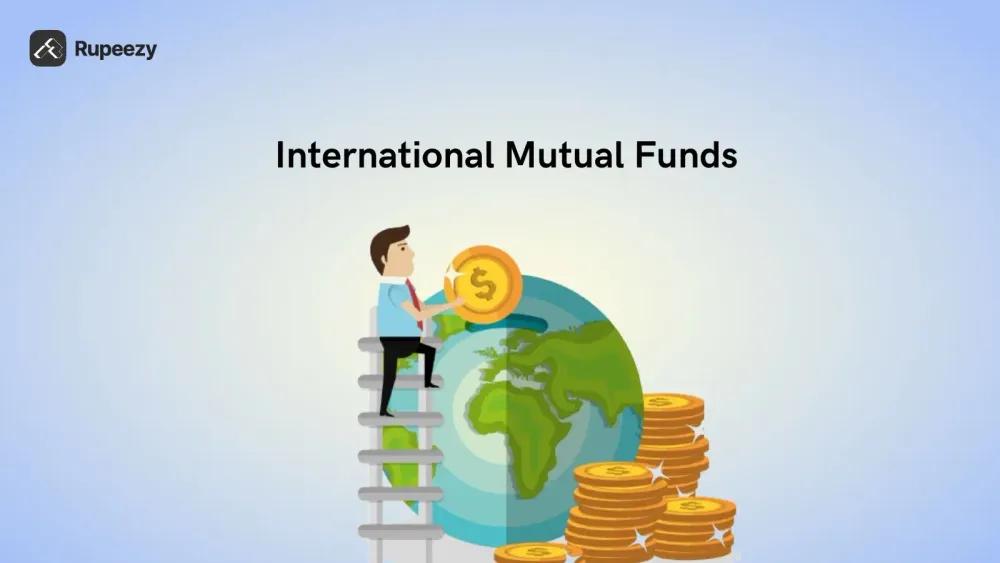Best International Mutual Funds in India 2025


00:00 / 00:00
In the world of investing, where volatility is the only constant, diversification is the way to be flexible. While your investments in domestic mutual funds are a great starting point, concentrating solely on the Indian market exposes your portfolio to single-country risk, such as a slowdown, policy shift, or sector concentration could impact your entire wealth.
This is where the concept of a Global Portfolio steps in. By expanding your exposure to foreign markets, you can hedge against domestic market cycles and benefit from growth opportunities in other countries, while also gaining access to cutting-edge sectors that are often unavailable in India. If the domestic market’s growth slows down, you can take advantage of the growth in markets across the US, Europe, or Emerging Asia countries.
To help you strategically expand your financial horizons, this article will explore what international mutual funds are, their features, the best international mutual funds in India 2025, and the criteria for selecting them, among other topics. Let us continue and understand more about it.
What exactly do International Mutual Funds mean?
International Mutual Funds (IMFs) gather funds from local investors and put them into assets located outside the investor's home country. This offers a vital way to diversify geographically.
These funds give you a simple way to benefit from global economic growth and foreign markets without dealing with complicated international rules yourself. The fund manager takes care of converting currency and choosing overseas assets, which makes investing worldwide both easy and convenient.
IMFs invest primarily in securities like stocks and bonds of companies listed on foreign exchanges. Generally, there are two main types of IMFs in India:
Some funds invest in a Fund of Funds (FoFs) structure, where the Indian scheme simply buys units of an established foreign fund or ETF.
Other schemes have directly invested in foreign stocks and securities themselves, building a proprietary global portfolio.
Finally, the investment aims to reduce portfolio risk by leveraging the low correlation between Indian and global markets.
Key Features of an International Mutual Fund
Here are five key features that define International Mutual Funds (IMFs) for Indian investors:
Geographical Diversification: IMFs can reduce single-country risk by investing across multiple economies. This diversification helps you to stabilize your portfolio while ensuring that a downturn in the Indian market does not negatively impact your entire portfolio.
Access to Global Market Leaders: These funds help Indian investors own a part of some of the world’s largest and most innovative companies, such as Nvidia, Microsoft, Apple, Alphabet, Amazon, and others.. You can capture growth and participate in industries that are underrepresented in the domestic market.
Hedge Against Currency Risk: Your investment, being denominated in a foreign currency such as the US Dollar, can act as a natural safeguard. If the Indian Rupee depreciates over your holding period, the conversion back to INR can boost your overall returns over and above the investment returns.
Professional Fund Management: Experienced fund managers actively research and manage these complex global portfolios on your behalf. They monitor diverse market risks, considering geopolitical and economic uncertainties, and make specialized investment decisions across time zones and regulatory environments.
Convenient Investment Route: Indian investors can invest through Domestic Asset Management Companies (AMCs) or through a trusted brokerage company like Rupeezy. This structure removes the complexities of opening foreign brokerage accounts, handling overseas compliance, and managing complicated remittances across countries.
Asset Allocation
Asset allocation is the fundamental decision of how to distribute your total investment capital across various asset classes like equity, debt, and gold to balance risk and reward. When integrating International Mutual Funds into your portfolio, you aren't just selecting a fund, you are deciding on geographical asset allocation.
The Rationale for Global Allocation
The primary goal of allocating funds to IMFs is geographical diversification and risk-adjusted returns. The Indian equity market represents only about 3% to 4% of the total global market capitalization, based on various sources. By keeping your entire corpus domestic, you’re ignoring the remaining 96% of the global opportunity set dominated by the US, European, and Chinese markets and remaining exposed to single-country risk. IMF allocation ensures that when the Indian market faces a correction, the lack of perfect correlation with global markets such as the US or European markets can help stabilize your overall portfolio.
The Practical Allocation Guideline
Financial planners often recommend a strategic allocation to international funds, treating them as a satellite or complementary asset class to your core domestic investments. Below is the table that allocation can be set based on your risk classification.
Investor Profile | Recommended Allocation to IMFs (as % of Total Portfolio) |
Conservative (Low-Risk Appetite) | 1% - 5% |
Moderate (Balanced Risk) | 5% -10% |
Aggressive (High-Risk Appetite) | 10% - 15% |
Note: The above allocation percentages are mentioned based on the writer's perspective, and it is not a recommendation. There is no fixed allocation for any risk class. The allocations can be made based on their risk appetite. Depending on the Geography, the allocations can be increased or decreased eventually. If the US markets are overvalued, you can trim some holdings and increase holdings in other geographies if the market is undervalued. Consult a Financial Advisor before investing.
How to select International Mutual Funds
Selecting an IMF means matching the fund's strategy with your own risk appetite and portfolio needs. Start by identifying why you need global exposure. Is it to access the US tech sector, diversify into emerging markets, or simply hedge against Rupee depreciation? Your answer will determine which fund category suits you best. Prioritizing funds with a clear mandate, low costs, and a consistent track record ensures you choose a robust long-term international partner.
Key Selection Criteria in Points:
Fund Mandate and Geographical Focus: Assess the fund's mandate, like does whether it targets a single country (e.g., US equity), a broad region (e.g., Europe), or offers global diversification. For core international exposure, stick to broad-based funds and avoid niche or thematic options.
Expense Ratio: International funds typically charge higher Expense Ratios due to complex operations. Look for index or passive FoFs tracking established benchmarks (like the Nasdaq 100 or S&P 500), as they often have the lowest running costs.
Risk Appetite: You must honestly assess your tolerance for market fluctuations and currency risk before investing globally. Choose funds aligned with your comfort level, favouring lower risk over high-volatility emerging or thematic funds.
Tracking Error: If you choose a passive fund tracking an index, check the tracking error. A low tracking error indicates the fund manager efficiently replicates the index's performance, ensuring you get the returns you expected without significant lag.
Fund Manager's Experience and Track Record: Evaluate the experience of the fund manager, particularly their expertise in global economic cycles and foreign currency management. Look for a minimum of 5 to 7 years of consistent, risk-adjusted performance, rather than just 1-year returns.
Correlation with Domestic Market: Select funds that historically show a low correlation with the Indian Nifty or Sensex. True diversification occurs when the foreign market moves independently of the domestic market, providing the maximum hedge during local downturns.
Tax Implications and Compliance: You should be aware that the IMFs are treated as non-equity funds, impacting capital gains tax rates. Select a fund after you understand the LTCG and STCG rules to avoid unexpected tax liabilities upon redemption.
Best International Mutual Funds in India 2025
We have compiled a list of the best International Mutual Funds in India 2025, based on their 3-year annualised returns. The following table details the best-performing international mutual funds:
Fund Name | Annualised Return (3 Years) |
41.07% | |
27.22% | |
26.97% | |
26.45% | |
25.30% | |
23.76% | |
23.69% | |
22.55% | |
21.93% | |
19.10% |
Note: This data is current as of October 15, 2025, and has been sourced from the Rupeezy Database. These returns are indicative and subject to change based on evolving market conditions and the performance of underlying funds. For the most up-to-date mutual fund returns, you can access the Rupeezy Platform.
Taxation on International Mutual Funds
Navigating the tax implications for International Mutual Funds (IMFs) in India requires careful attention, as the rules differ significantly from domestic equity funds. Since IMFs primarily invest in foreign equities, they generally do not meet the Income Tax Act's threshold of investing at least 65% in Indian equities required for 'equity-oriented' mutual fund status. Consequently, IMFs are typically classified as non-equity or debt-like investments. This classification dictates the method for calculating Short-Term and Long-Term Capital Gains (CG), which is determined by the investor's holding period at the time of redemption, following the rules applicable to non-equity mutual funds.
The current tax regime for IMFs is based on the amendments from the recent Finance Acts and is generally applied as follows:
Capital Gains Taxation on International Mutual Funds
1. Short-Term Capital Gains (STCG)
Holding Period: If purchased on or after April 1, 2025, and if you hold the mutual fund units for less than 24 months before selling them, the gains are treated as STCG as per the recent budget amendments.
Tax Rate: The capital gain amount out of this will be taxed at the slab rate based on their respective income slab, like 10%, 15%, 25%, 30% and so on.
2. Long-Term Capital Gains (LTCG)
Holding Period: If purchased on or after April 1, 2025, and if you hold the mutual fund units for more than 24 months before selling them, the gains are treated as LTCG as per the recent budget amendments.
Tax Rate: The investor is taxed at a fixed rate of 12.5% without indexation benefit.
3. Dividend Taxation
The dividend income received from the International Mutual Fund is treated under “Income from Other Sources” in the hands of the investor. The dividend income will be added to your total annual income and taxed at your applicable income tax slab rate.
Advantages and Disadvantages of an International Mutual Fund
Here are some of the advantages and disadvantages of investing in an International Mutual Fund.
Advantages:
Geographical Diversification: IMFs allow you to spread investment risk beyond your home country. When the Indian market underperforms due to local issues, a portion of your portfolio invested in booming foreign economies like the US or Europe can help stabilize overall returns and reduce reliance on a single economic cycle.
Access to Global Leaders & Sectors: These funds enable investment in the world's most innovative and largest companies (e.g., Apple, Microsoft, Tesla), which may not be listed in India. This access allows your portfolio to benefit from global growth themes like advanced technology, specialized healthcare, or high-end consumer trends.
Hedge Against Rupee Depreciation: When you invest in an IMF, your money is converted into foreign currency like USD or EUR. If the Indian Rupee weakens against these currencies over time, the value of your overseas holdings in Rupee terms increases, offering a valuable long-term currency protection.
Lower Correlation for Portfolio Stability: Global markets often do not move in perfect tandem with the domestic market. Investing in assets with low correlation means that when Indian stocks fall, international stocks might rise or remain stable. This lack of synchronized movement enhances the resilience and provides a smoother growth curve for your entire portfolio.
Disadvantages:
Exposure to Currency Risk: While currency fluctuations can be an advantage, they can also be a significant risk. If the Indian Rupee strengthens sharply against the foreign currency, the returns you earn overseas will translate into lower profits when converted back into Rupees, potentially eroding your gains.
Geopolitical and Regulatory Risks: Your investment performance is prone to political instability, regulatory changes, or economic crises in the host country, such as trade wars or unexpected tariffs. These foreign government interventions and political decisions are outside the control of the Indian fund manager and can lead to sudden value drops.
Difficulty in Analysis and Due Diligence: For the average Indian investor, assessing the economic and market factors of a foreign country, like US Fed policy or Chinese trade data, is challenging. It is harder to judge the performance and risk management of the fund manager, given the lack of local context and understanding of overseas regulations.
How to Invest in International Funds?
Investing in International Mutual Funds (IMFs) is significantly simpler than investing in individual foreign stocks. Prominent Brokerage companies like Rupeezy offer access to investing in these International Mutual Funds, and one can do so by following these steps:
Creating an account: Get started by downloading a mutual fund app from either the Google Play Store or the Apple App Store, and then complete the KYC process to open your investment account.
Browse the fund types: Head over to the Explore section to see the different fund categories available, which include Global, or one can search the fund directly through the search.
Identify Funds: Look closely into the funds and analyze the specific mutual funds you are considering for your investment.
Evaluate fund details and performance: Compare various mutual funds based on key factors like their past performance, the expense ratios, and other parameters. This analysis will help you select a fund that aligns with your financial goals, offering strong returns while keeping costs low.
Make your investment based on your choice: You can now invest in your chosen mutual fund using a lump sum (one-time payment) or through a Systematic Investment Plan (SIP). Be sure to continuously monitor your investments and make adjustments as required.
Conclusion
To sum up this article, International Mutual Funds (IMFs) are essential for modern investing. They effectively diversify your portfolio by investing in global assets, which can help stabilize your portfolio when the domestic market faces a downturn. IMFs give you a simple way to access global leaders and benefit from worldwide growth without the hassle of foreign compliance, as professional fund managers handle all the complexity for you. Ultimately, IMFs make your portfolio stronger and less reliant on a single economy. Consult a Financial Advisor before investing and choose based on your risk tolerance.
FAQ:
Q1) How to start a SIP in an International Mutual Fund?
You start an SIP just like any domestic fund by completing your KYC, and choosing a fund on a platform like Rupeezy or through the AMC website, then selecting the SIP or Lumpsum option.
Q2) What is the biggest advantage of investing in International Mutual Funds?
The biggest advantage is Geographical Diversification. It reduces the risk of your entire portfolio being affected by a slowdown or volatility in only the Indian market.
Q3) How are International Mutual Funds taxed in India?
IMFs are generally taxed like debt funds. Gains held for less than 24 months (STCG) are taxed at your income slab rate; gains held for more than 24 months (LTCG) are taxed at a fixed rate of 12.5% (without indexation) for units bought after April 1, 2025.
Q4) What are the key risks of investing in IMFs for Indian investors?
The primary risks are Currency Fluctuation Risk (Rupee appreciation can reduce returns), Geopolitical Risk (instability in foreign markets), and Market Volatility overseas.
Q5) How can an Indian investor invest in International Mutual Funds?
The easiest way to invest is through a Prominent Brokerage company like Rupeezy or an Asset Management Company (AMCs). You can invest via a Fund of Funds (FoF) structure or funds that directly buy foreign securities, using SIP or Lumpsum.
The content on this blog is for educational purposes only and should not be considered investment advice. While we strive for accuracy, some information may contain errors or delays in updates.
Mentions of stocks or investment products are solely for informational purposes and do not constitute recommendations. Investors should conduct their own research before making any decisions.
Investing in financial markets are subject to market risks, and past performance does not guarantee future results. It is advisable to consult a qualified financial professional, review official documents, and verify information independently before making investment decisions.

All Category









